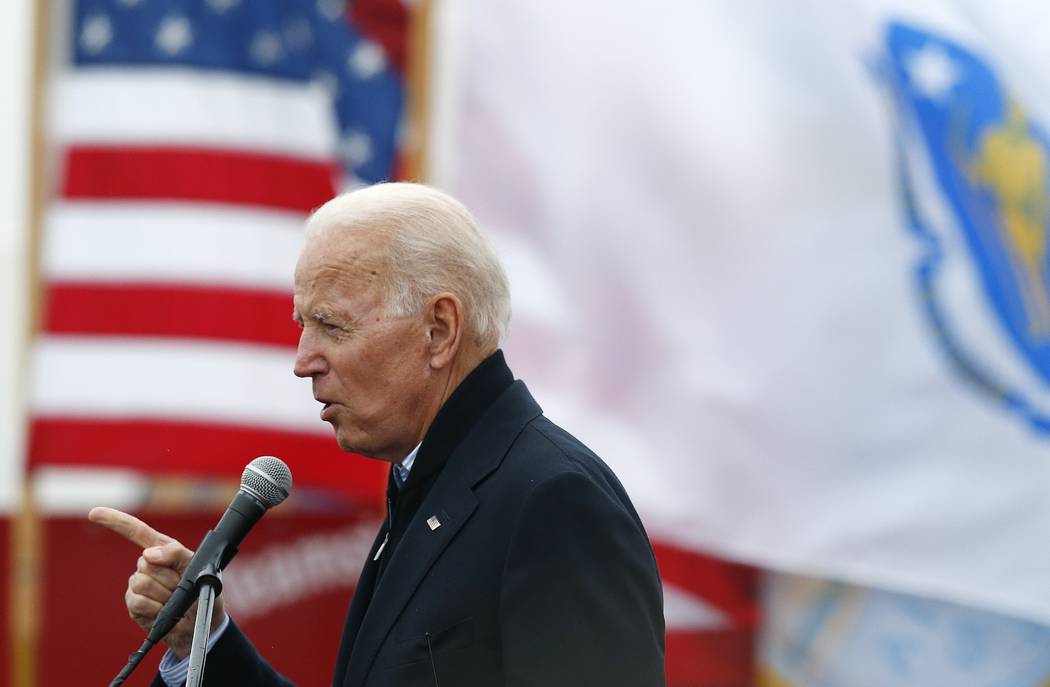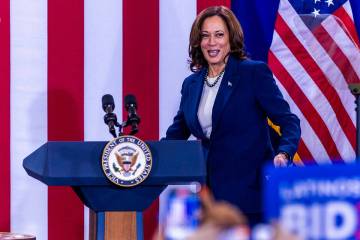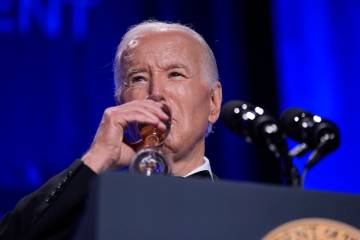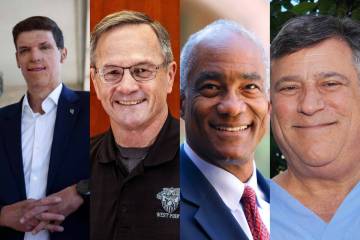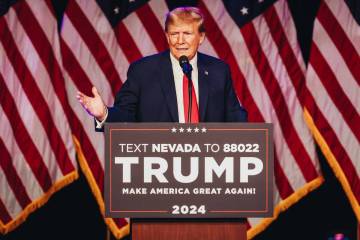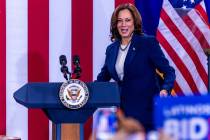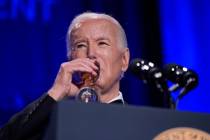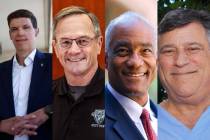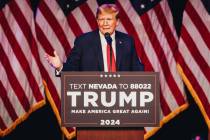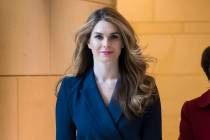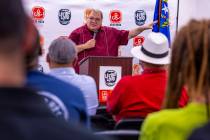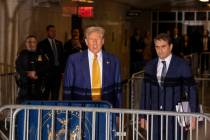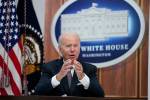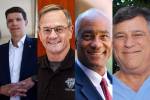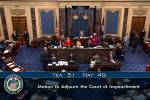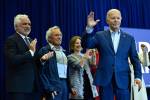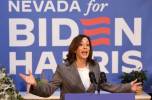Hatred at Charlottesville stunned, ignited Biden’s third bid
Joe Biden spent a hot August day at his lakefront Delaware home watching hatred on display in Charlottesville, Virginia, where, days earlier, torch-wielding white supremacists had marched through town. A counter-protester advocating racial equality was killed when a white supremacist drove his car into a crowd.
When President Donald Trump blamed the violence on “both sides,” the former vice president says he was stunned.
He turned to his closest advisers — his family — to discuss what to do next.
Spread out across the country, the Bidens quickly convened through a series of group text messages. For months, they’d weighed whether Biden, whose two prior White House campaigns were abject failures, should try again.
There was now consensus: Prepare to run against Trump.
Biden’s sister and longtime political confidante, Valerie Biden Owens, described Trump’s comments as a “blow” to the man who had served as the No. 2 to America’s first black president.
“It really started percolating, and the essence of this was Charlottesville,” Biden Owens said. “I can tell you that was a major motivating moment for my brother, and the entire family.”
“The big ‘yes’ started with this,” said Ted Kaufman, Biden’s longtime Senate chief of staff.
Trump blasted in video
Nearly two years later, Biden made it official on Thursday when he announced in a video that he would seek the Democratic presidential nomination again. He blasted Trump’s “moral equivalence between those spreading hate and those with the courage to stand against it” and declared the election a “battle for the soul of this nation.”
Biden is positioning himself as the anti-Trump, an experienced elder statesman ready to restore stability to Washington.
But he faces steep challenges. He’s staking his candidacy on an appeal to the white working-class voters who swung to Trump in 2016, but he must also energize black voters.
At 76, he’s the second oldest contender in the race (behind Bernie Sanders) at a time when many Democratic activists yearn for generational change. He sees his decades in public life as an asset. Others see it as a minefield of views on race and personal behavior that no longer match the modern Democratic Party.
His candidacy will serve as a fresh referendum on the eight years of the Obama administration, which some Democrats are beginning to view more critically.
But none of that dissuaded Biden from running.
This account of how he arrived at his decision is based on interviews with more than a dozen aides, longtime friends, advisers and family members who have discussed his deliberation over the past three years. Some requested anonymity in order to speak candidly about their conversations and observations.
Little arm twisting
It didn’t take that much arm twisting. Biden was ready to run in 2016 before his elder son, Beau, succumbed to brain cancer and left him navigating a grief so intense that the rigor of a presidential campaign was out of the question.
“It started out ‘yes’ and he had every intention of running, but ran up against the unthinkable and the only answer was ‘no,’” Biden Owens said.
The regret was palpable after Trump’s win. In January 2017, two weeks before he would hand the vice presidency over to Mike Pence, Biden was on Capitol Hill to unveil his official portrait. Notoriously chatty, he gave a glimpse of his thinking.
“I might just do it,” Biden remarked to a small cadre of staff, some of whom were taken aback that he was already entertaining the idea.
He stayed in regular touch with former President Barack Obama after they left the White House, by phone and in person. Those early conversations after Trump’s inauguration were more about their own personal transitions out of government than Biden’s possible political plans.
But Biden’s interest in another presidential campaign quickly became clear. By May 2017, he started a political action committee to support Democrats in the upcoming midterm elections. He solicited donors — something he’s never enjoyed — and began mapping out a plan to be a prominent player in the Democratic bid to regain the House and defend difficult seats in the Senate.
As the midterms neared, Biden started getting the feedback he hoped for. In August 2018, he boarded a flight from Washington to New York and a string of passengers encouraged him to run in 2020.
The midterm effort wasn’t merely a vanity project for an aging politician wanting to stay in the game. It was a test run of Biden’s message, influence and personal stamina.
Biden campaigned for 65 candidates in 24 states, a pace that accelerated to include 13 cities in the last six days. In the final weeks of the campaign, he swung through Iowa, home to the nation’s first presidential caucuses.
His combination of midterm travel and financial contributions were outdone by few, if any, of his would-be 2020 rivals.
After Democrats won the House, Biden spent much of the winter in his two-story brick house in suburban McLean, Virginia, plotting his next steps. He regularly called friends, longtime supporters and potential donors to get their views of the emerging presidential field. He pressed people on whether they thought he was too old to run.
By the time Teri Goodman, one of Biden’s most enduring Iowa confidantes, arrived in Virginia in mid-February 2019, the dining room table was strewn with newspapers, files and briefing books. The two old friends retired to a sitting room where they chatted about the early stages of the race in Iowa as Biden’s German Shepherd puppy, Major, flounced around and Major’s older counterpart, Champ, sat quietly.
Goodman said there was no ambiguity about Biden’s plans.
“I believed he was going to run,” she said. “He was actively engaged, involved in these things.”
Liabilities clear
“I’m his sister. I know he doesn’t walk on water,” Biden Owens said. “The man has flaws like we all do. But this is a man who is decent.”
As he moved toward a campaign, Biden’s liabilities were clear. He has faced sharp criticism for his pointed questioning of Anita Hill, the African American woman who leveled sexual harassment claims at Supreme Court nominee Clarence Thomas in 1991. Biden has also been blasted for his role in crafting the 1994 crime bill, which is now blamed for disproportionately imprisoning hundreds of thousands of young black men.
More recently, he’s faced scrutiny for his past opposition to mandatory school busing in the 1970s to achieve integration.
Biden recognized those vulnerabilities early on, studying a briefing book that included discussions of how his long record in public life could be seen differently in 2019 — and used against him.
Less prepared for Flores
He was less prepared for what happened on the afternoon of Friday, March 29. Lucy Flores, Nevada’s Democratic nominee for lieutenant governor in 2014, wrote an essay saying that, as vice president, Biden approached her from behind, put his hands on her shoulders, smelled her hair and kissed the back of her head.
Flores said the encounter wasn’t violent or sexual, but was “demeaning and disrespectful.” Biden was suddenly on the wrong side in the #MeToo era. He hadn’t launched a campaign, but was already facing calls not to run.
He first seemed to deflect, saying in a written statement he did not recall the episode. He went on to say that “not once — never — did I believe I acted inappropriately.” He pledged to listen to women who were sharing their stories.
As negative reaction mounted, Biden’s team struck back more aggressively, blaming “right wing trolls” from “the dark recesses of the internet” for conflating uninvited touching with images of the notoriously affectionate Biden hugging women and children.
Another woman soon shared a story of how Biden touched her face with both hands and rubbed noses with her in 2009 when he was thanking aides who arranged an event in Connecticut.
As the week ticked on, news clattered away about whether Biden’s patriarchal persona put him out of step with the times.
Biden was nowhere to be seen. It took nearly a week before he posted a two-minute video of him recounting how expressions of affection had helped him but “social norms have begun to change.”
“They’ve shifted and the boundaries of protecting personal space have been reset, and I get it. I get it,” he said. “And I’ll be much more mindful. That’s my responsibility.”
But when he spoke to a union audience in his first public appearance after the controversy, Biden seemed to joke about the issue. He noted the embrace he shared with a male union president, Lonnie Stephenson.
“I just want you to know, I had permission to hug Lonnie,” Biden said, to the cheers of the mostly male crowd.
His message was clear: Biden would run as himself, flaws and all.
——
Beaumont wrote from Des Moines, Iowa. Associated Press writer Julie Pace in Washington contributed to this report.



